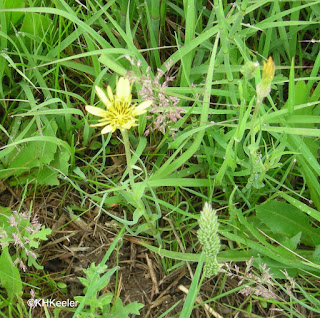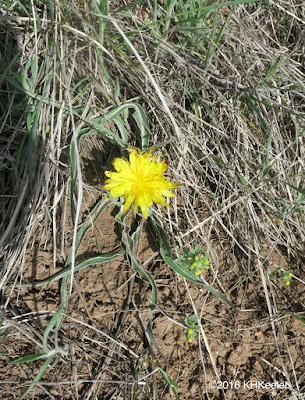Five days later (see last week's blog) I revisited Horsetooth Waterfall Trail, this time on a sunny morning after three days of warm weather.
Flowers that close in cold weather were open!
That included dandelions and false salsify (Podospermum laciniatum (or Scorzonera laciniata), dandelion family Asteraceae).
 |
| false salsify also called cutleaf viper grass |
Here's a photo of 'real' salsify, Tragopogon dubius, also in the dandelion family. The flowers are similar but the buds of false salsify are more "bulbous" than those of salsify and false salsify branches more.
 |
| salsify, Tragopogon dubious |
THEN I saw wavy-leaved dandelions, Nothocalais cuspidata. This little plant is native. It was a treat, they are not very common. (Or perhaps, easily taken for a common dandelion and overlooked).
 |
| wavy-leaved dandelion, Nothocalais cuspidata |
 |
| another wavy-leaved dandelion |
 |
| spring beauty on a cool day |
 |
| spring beauty, Claytonia rosea |
I was too hasty and didn't get a good close up photo of the spring beauty. They're extremely lovely flowers, look closely when you see them!
 |
| spring beauty, Claytonia rosea |
 |
| Colorado loco, Oxytropis lambertii |
 |
| larkspur, Delphinium sp. |
 |
| Lithospermum incisum, fringed puccoon |
 |
| creeping barberry, Berberis (Mahonia) repens |
The growing season is just getting started: among the wild alyssum seed pods below are the yellow-and-orange almost-open buds of sulphur flower (Eriogonum umbellatum, buckwheat family Polygonaceae). Open flowers: link
 |
| Among the wild alyssum, buds on sulphur flower |
Walking out, there were lots of fascinating flowers, native and introduced.
The struggle to name the plants accurately too often eclipsed enjoying other stories about them. For example:
The false salsify, wavy-leaved dandelion and of course the common dandelion (Taraxacum officinale blog post) only open their flowers when its warm enough (sunny). You'll work much harder to spot them on a cool or cloudy day.
Finding that plants of the same species, growing together, have different numbers of chromosomes (are polyploid) is a hot research area in botany currently. The eastern relative of our spring beauty, Claytonia virginica, was shown 50 years ago to have local populations where the different plants had different numbers of chromosomes, from 12 to 190! Shocking, because when chromosome numbers differ in animals, it produces all kinds of problems. In plants it doesn't seem to matter much, as the classical studies of Virginia spring beauty showed. Does the Rocky Mountain spring beauty have as diverse chromosomes as Virginia spring beauty? Apparently not. All plants studied have 16 chromosomes. Why are relatives so different? Good question!
Colorado loco, although in the pea family, is toxic, the "loco" referring to the behavior of livestock that ate very much of it.
Larkspurs are toxic also. Many larkspurs are for sale as garden plants, called either larkspurs or delphiniums. Whether American or European, they are all poisonous. Fortunately they don't look like anything people ordinarily eat. If you leave them alone, they won't hurt you.
The name puccoon is a Virginia Algonquin word for a dye plant. It was what they called an eastern species of Lithospermum. The roots of fringed puccoon are reported to have made a blue and violet dye for Great Basin and Montana Indians.
Creeping barberry berries were a famine food of Native Americans in the west, edible but unappealing.
It was a beautiful day to look for wildflowers!
Comments and corrections welcome.
The struggle to name the plants accurately too often eclipsed enjoying other stories about them. For example:
The false salsify, wavy-leaved dandelion and of course the common dandelion (Taraxacum officinale blog post) only open their flowers when its warm enough (sunny). You'll work much harder to spot them on a cool or cloudy day.
Finding that plants of the same species, growing together, have different numbers of chromosomes (are polyploid) is a hot research area in botany currently. The eastern relative of our spring beauty, Claytonia virginica, was shown 50 years ago to have local populations where the different plants had different numbers of chromosomes, from 12 to 190! Shocking, because when chromosome numbers differ in animals, it produces all kinds of problems. In plants it doesn't seem to matter much, as the classical studies of Virginia spring beauty showed. Does the Rocky Mountain spring beauty have as diverse chromosomes as Virginia spring beauty? Apparently not. All plants studied have 16 chromosomes. Why are relatives so different? Good question!
Colorado loco, although in the pea family, is toxic, the "loco" referring to the behavior of livestock that ate very much of it.
Larkspurs are toxic also. Many larkspurs are for sale as garden plants, called either larkspurs or delphiniums. Whether American or European, they are all poisonous. Fortunately they don't look like anything people ordinarily eat. If you leave them alone, they won't hurt you.
The name puccoon is a Virginia Algonquin word for a dye plant. It was what they called an eastern species of Lithospermum. The roots of fringed puccoon are reported to have made a blue and violet dye for Great Basin and Montana Indians.
Creeping barberry berries were a famine food of Native Americans in the west, edible but unappealing.
It was a beautiful day to look for wildflowers!
Comments and corrections welcome.
For identifying Larimer County plants:
Ackerfield, J. 2015. Flora of Colorado. B.R.I.T. Press, Fort Worth, TX.
Young, H. 2014. Wildflowers and Other Plants of the Larimer County Foothills Region. Larimer County Natural Resources.
Other sources I consulted:
Young, H. 2014. Wildflowers and Other Plants of the Larimer County Foothills Region. Larimer County Natural Resources.
Other sources I consulted:
Eland, S. C. 2013. Plant Biographies (published as a CD, see Amazon.com)
Halleck, D K. and D. Wiens. 1966. Taxonomic status of Claytonia rosea and C. lanceolata (Portulacaceae). Annals of the Missouri Botanical Garden. 53: 205-212.
Lewis, W. H., and J. Semple. 1977. Geography of Claytonia virginica cytotypes. American Journal of Botany. 64: 1078-1082. (Summary of several studies.)
Miller, J.M. "Claytonia" Flora of North America http://www.efloras.org/florataxon.aspx?flora_id=1&taxon_id=107275A ccessed 5/15/16.
Halleck, D K. and D. Wiens. 1966. Taxonomic status of Claytonia rosea and C. lanceolata (Portulacaceae). Annals of the Missouri Botanical Garden. 53: 205-212.
Lewis, W. H., and J. Semple. 1977. Geography of Claytonia virginica cytotypes. American Journal of Botany. 64: 1078-1082. (Summary of several studies.)
Miller, J.M. "Claytonia" Flora of North America http://www.efloras.org/florataxon.aspx?flora_id=1&taxon_id=107275A ccessed 5/15/16.
Moerman, D. E. 1998. Native American Ethnobotany. Timber Press, Portland, OR.
"puccoon, n." OED Online. March 2016. Oxford University Press. http://0-www.oed.com.library.unl.edu/view/Entry/154085?redirectedFrom=puccoon (accessed May 15, 2016).
"puccoon, n." OED Online. March 2016. Oxford University Press. http://0-www.oed.com.library.unl.edu/view/Entry/154085?redirectedFrom=puccoon (accessed May 15, 2016).
Strother, J. L. "Scorzonera" Flora of North America link Accessed 5/13/16.
Whittlemore, A. T. "Berberis"Flora of North America link Accessed 5/13/16.
Kathy Keeler, A Wandering Botanist
Join me on Facebook: https://www.facebook.com/AWanderingBotanist
Kathy Keeler, A Wandering Botanist
More at awanderingbotanist.com


Cutleaf...whatever they want to call it is edible: file:///Users/admin/Downloads/6778-17752-1-PB.pdf
ReplyDelete